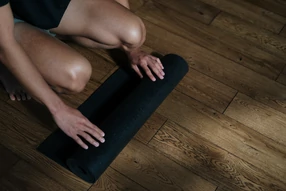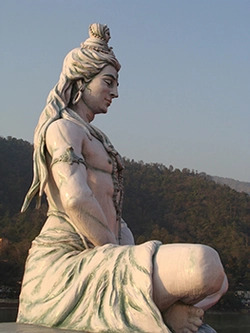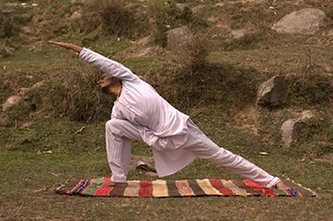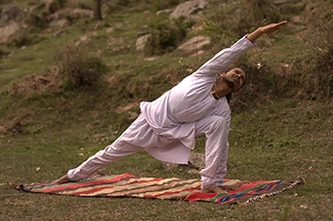

In Sanskrit, Yoga means "union" and "to yoke." When referring to the definition as a union, this union can be between your Consciousness or the Individual Consciousness and the Universal Consciousness or the Creator, your feminine and masculine aspects, uniting the four paths of Yoga, the right and left hemispheres of the brain and the list can continue.

Understandably this may sound wrong or impossible because no one knows exactly when Shiva incarnated. What we have today to work with is a detailed description of the night sky that was passed down from generation to generation, with this information it is an estimated time line using software that tracks the night sky.
Before this practice as written down it was passed down from Guru meaning "spiritual teacher" to student. The student was not only expected to learn the practices but was also expected to be able to recite the philosophy of the practice. When referring to this practice most people think of Hatha Yoga as the practice of Yoga, but Hatha Yoga is just one technique in the whole scope of this practice.
In Sanskrit, Vidya means knowledge, clarity or higher learning. Vidya is also the name of a Hindu goddess who personifies knowledge. Yoga Vidya is the science of Yoga with the practices Asana, Hasta Mudra, Mudra, Mantra, Bandha, Pranayama, Dhyana and Shatkarma.
This practice should be used by the practitioner as a vessel or vehicle for discovering the true nature of the Higher Self and uniting with the Divine. This is the true purpose of this practice and can be achieved through any of the techniques of Yoga.This practice is known as Vedanta which is a philosophy founded by Shankara who lived in the eight century. In Sanskrit "Veda" means complete knowledge and "Anta" means end, therefore this practice is the last stage in a spiritual journey.
With this there are several paths with none being superior except the path that the practitioner is on. All techniques a known to lead the practitioner to the ultimate goal of this practice which is the union between the practitioner and the Creator.
As the practitioner deepens the practice, the practitioner maybe attracted or pulled to a different technique. If this happens, that is fine, listen to the Higher Self or the inner Guru meaning "spiritual teacher" and allow the path to unfold in front of you.
Traditionally a Guru was sought after for the knowledge and guidance need for this journey and even today a Guru is needed. The practitioner will eventually get to a point where proper guidance and deeper knowledge is needed.
The breath is vital for life as it provides oxygen and Prana to the body but how we breath is important. When we inhale through the nose we can take in a full breath allowing the lungs to completely inflate, the air is filtered by the hairs in our nose and the two main Nadis are stimulated.

Breathing through the nose is known to lower the blood pressure and reduce stress, but during exercising or preforming strenuous activities, breathing through the nose requires less effort and is known to lower the systolic blood pressure. Therefore as we practice, breathing through the nose is an important factor when practicing.
While practicing the breath plays an important role because as we breath with the movements of an Asana practice, we are able to preform that pose easier, helps to correct improper breathing habits as well as calming the mind.
The practice of Yoga Asana or the physical poses have become popular in recent time, but this is just one of many practices in the whole scope of a practice. This practice should be seen as a science and not an exercise or stretching practice.

One practice is Pranayama or breathing exercises and are mentioned in several Yogic text as to have the ability to extend the practitioner's life span as well as improve breathing. Practicing the Ujjayi Pranayama is know to lower the blood pressure, reduce stress and calm the mind among other benefitsknowledge is needed.
A spiritual practice is one that shows the practitioner that the egoic self or the false self is currently in control and is the cause of all issues in life which cause a level of unease or unhappiness.
When the practitioner is able to see themselves moving into an egoic state, the practitioner has the choice to then move back into the Higher Self.
A spiritual practice is about having spiritual experiences which can not be put into words. In fact all experiences can not be put into words but instead must be experienced in order to understand the experience.
With that said when Prana is allowed to flow freely throughout the Nadis and therefore throughout the entire body, the practitioner can then use this energy and direct it towards Self-Realization or the union between the Creator and created.
Each technique has there own path to Self-Realization with no techniques be superior to another. If the practitioner practices with the highest intend, dedication and faith, then any technique will bring about an awaking on some level.
Every practice within Yoga has spiritual benefits as well as mental and physical benefits. If this practice is preformed correctly then the mental and physical benefits will happen.
As for the spiritual benefits, they may start to flower but without intent, dedication and a partial or complete release of the material world, the practitioner will find Self-Realization a difficult journey.